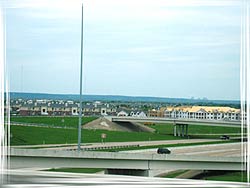Texas Eco-Regions
Eastern Cross Timbers back to Eco-Regions Map
Elevation
Elevation ranges from 400 feet above sea level in the Trinity River basin to over 1700 feet in the west.
Precipitation
Tarrant County in the east receives approximately 32 inches of rainfall per year while Wichita County in the northwest averages 27 inches per year.
Topography
Streamside areas contain bottomland forests of such species as pecan, bur oak, American and slippery elm, ashes, cottonwood, sugarberry and black willow.
Soils
The Eastern Cross Timbers soils have sandy to loam soils that are acidic to neutral. This dramatically affects what plants grow in each area. The sandy acidic soils of the Eastern Cross Timbers are in sharp contrast to the heavy fertile soils of the Blacklands and Grand Prairie and Plains.
Vegetation Description
In north central Texas, the Eastern Cross Timbers vegetative sub-region is a narrow strip of timbered country extending from eastern Cooke County on the Red River south to western Hill County and includes portions of Denton, Tarrant, Johnson, and Hill Counties. Today, few large tracts of undisturbed woodlands remain in the Eastern Cross Timbers which is perhaps the most fragmented vegetative region in Texas.
Impacts of Fire
Fire has a major impact on the vegetation, especially in the prairie areas. Traditionally these were fire dominated regions and periodic fires kept much of the trees and woody vegetation out of prairie. As fire has been eliminated from much of this area, it has been invaded with woody vegetation and is no longer a prairie. In the Eastern Cross Timbers, sporadic fires created a patchwork of woodlands and meadows. Within the wooded areas, fire often kept the understory clear and open.
Historical Information
From Irving, Washington, 1886. A Tour of the Prairies. John B. Alden, New York: " The Cross Timber is about forty miles in breadth and stretches over a rough country of rolling hills, covered with scattered tracts of post-oak and black-jack; with some intervening valleys, which at proper seasons, would afford good pasturage. It is very much cut up by deep ravines, which in the rainy seasons, are the beds of temporary streams, tributary to the main rivers, and these are called "branches". The whole tract may present a pleasant aspect in the fresh time of the year, when the ground is covered with herbage; when the trees are in their green leaf, and the glens are enlivened by running streams. I shall not easily forget the mortal toil and vexations of the flesh and spirit that we underwent occasionally, in our wanderings through the Cross Timber. It was like struggling through forests of cast iron." pp. 78-79. * Courtesy of The Ancient Cross Timbers Consortium, http://www.uark.edu/misc/xtimber/.
Other
Oil production, ranching and farming have been major activities in this region for over eighty years.


